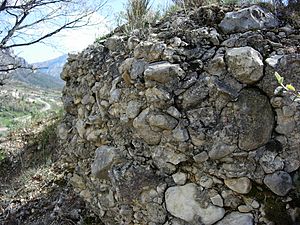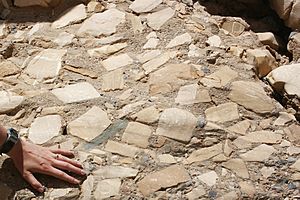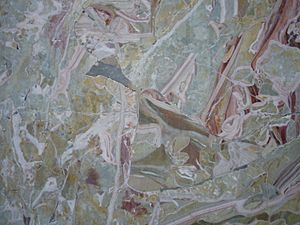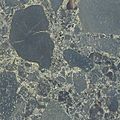Clastic rock facts for kids
Clastic rocks are special rocks made from tiny pieces or fragments of older rocks. These pieces are called clasts. Imagine a puzzle where all the pieces are bits of other rocks!
These rock pieces can be very small, like sand, or much bigger, like pebbles or even huge boulders. When we talk about clastic rocks, we usually mean rocks with pieces big enough to see without a magnifying glass.
Contents
Types of Clastic Rocks
There are two main types of clastic rocks. We tell them apart by the shape of their clasts.
Conglomerates: Rounded Pieces
If the rock pieces (clasts) are smooth and rounded, the rock is called a conglomerate. These rounded shapes often mean the pieces were tumbled around by water, like in a river or on a beach. This tumbling wears down the sharp edges.
Breccias: Jagged Pieces
If the rock pieces (clasts) are sharp and jagged, the rock is called a breccia. The sharp edges mean the pieces probably didn't travel far. They might have broken off a cliff and then been cemented together quickly.
How Clastic Rocks Form
Clastic rocks form when older rocks break down into smaller pieces. This breaking down can happen because of wind, water, or ice. These small pieces are then moved by nature, like by rivers or glaciers.
Over time, these pieces settle in a new place. More and more layers of pieces build up. The weight of the layers above squishes them together. Minerals in water can also act like glue, cementing the pieces together. This process turns loose bits into solid rock.
Clasts and Matrix
In a clastic rock, you often see two main parts. The bigger pieces are the clasts. The smaller bits, like sand or mud, that fill the spaces between the clasts are called the matrix. The clasts and the matrix can be made of different types of rock or minerals.
Examples of Clastic Rocks
Many common rocks are clastic.
- Sandstone is a clastic rock made mostly of sand-sized grains.
- Mudstone and shale are made from very tiny mud or clay particles.
- Conglomerate and breccia are made from larger, gravel-sized pieces.
These rocks tell us a lot about Earth's history. They show us where rivers flowed, where ancient beaches were, or where mountains crumbled.
Images for kids
See also
 In Spanish: Roca clástica para niños
In Spanish: Roca clástica para niños










